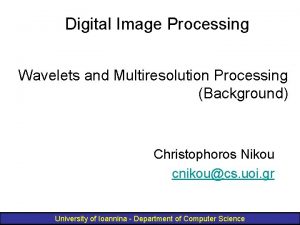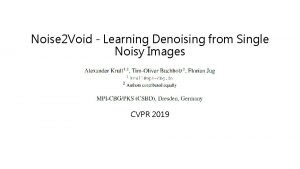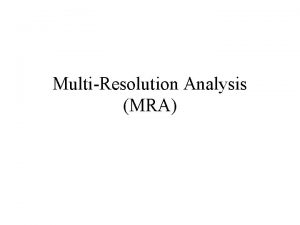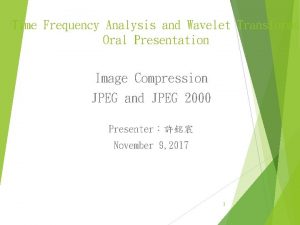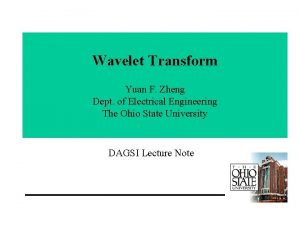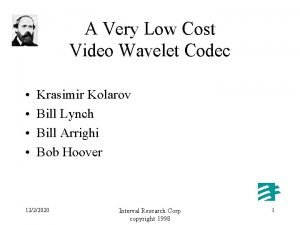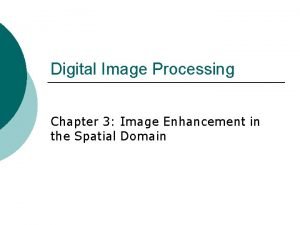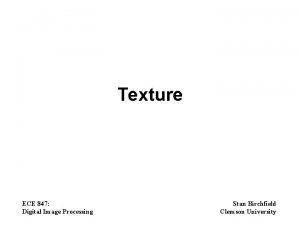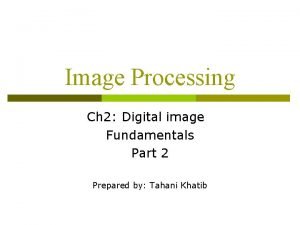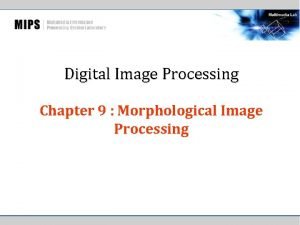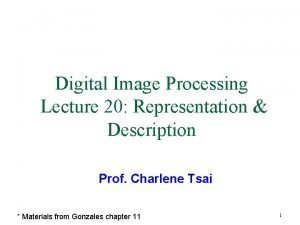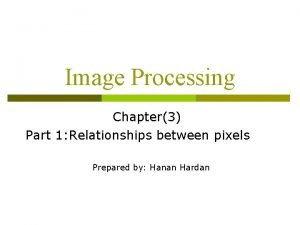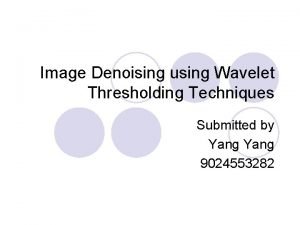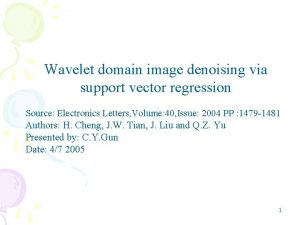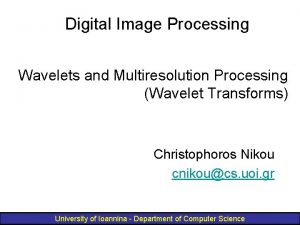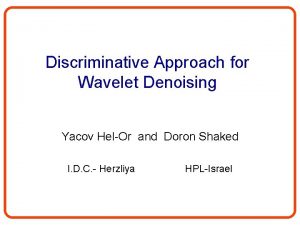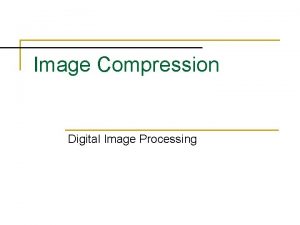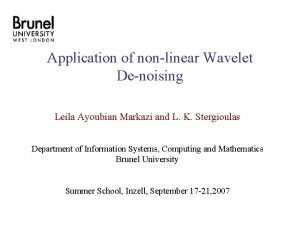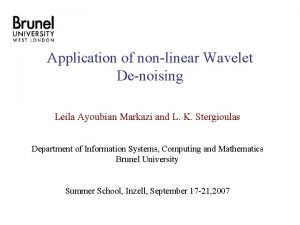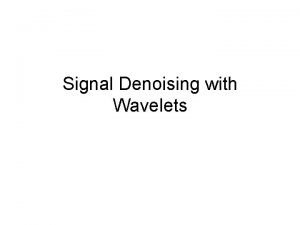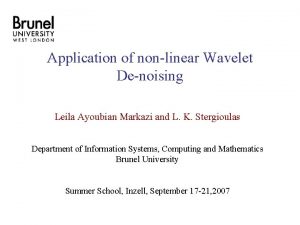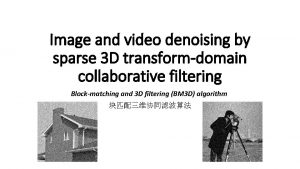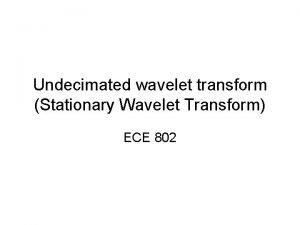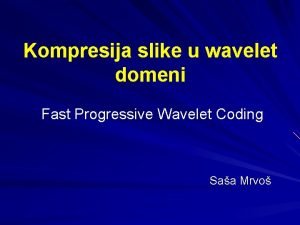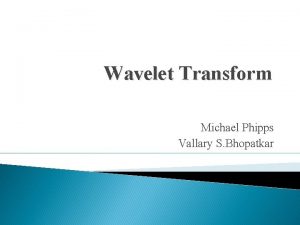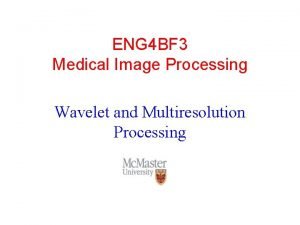Image and Video Processing III 3 Wavelet Denoising


















































- Slides: 50

Image and Video Processing

III. 3 Wavelet Denoising for Image Enhancement • • • 1 Introduction 2 Wavelet Transform 3 Wavelet Shrinkage Denoising 4 Image Enhancement Wavelet Shrinkage 5 Examples

1 Introduction •

1 Introduction a) b) a) The familiar Fourier expansion function sinusoids of varying frequency and infinite duration b) DWT expansion functions are “small wave” of finite duration and varying frequency

1 Introduction Multiresolution theory • Image pyramids an image pyramid is a collection of decreasing resolution images arranged in the shape of a pyramid the base of the pyramid contains a high-resolution representation of the image being processed; the apex contains a low-resolution approximation

1 Introduction Multiresolution theory • Subband coding in subband coding, an image is decomposed into a set of bandlimited components, called subbands. The decomposition is performed so that the subbands can be reassembled to reconstruct the original image without error.



1 Introduction •

1 Introduction •

1 Introduction Multiresolution Expansion • Scaling functions

1 Introduction • The relationship between scaling and wavelet function spaces

1 Introduction

2 Wavelet Transform 2. 1 The Discrete Wavelet Transform •

2 Wavelet Transform 2. 1 The Discrete Wavelet Transform •

2 Wavelet Transform 2. 1 The Discrete Wavelet Transform •

2 Wavelet Transform 2. 1 The Discrete Wavelet Transform •

2 Wavelet Transform 2. 1 The Discrete Wavelet Transform The output of the inverse DWT is identical to the input of the forward DWT and the resulting DWT is an orthonormal transform

2 Wavelet Transform 2. 1 The Discrete Wavelet Transform The output of the inverse DWT is identical to the input of the forward DWT and the resulting DWT is an orthonormal transform

2 Wavelet Transform 2. 1 The Discrete Wavelet Transform •

2 Wavelet Transform 2. 1 The Discrete Wavelet Transform 2 -D fast wavelet transform: the analysis filter bank

2 Wavelet Transform 2. 1 The Discrete Wavelet Transform • two-level inverse DWT The inner products of f(x, y) and two-dimensional scaling and wavelet function, downsampling by 2 in each dimension.



2 Wavelet Transform 2. 1 The Discrete Wavelet Transform Computing a 2 -D three-scale FWT a a)The original image b)a one-scale FWT c)a two-scale FWT d)a three-scale FWT c b d

2 Wavelet Transform 2. 1 The Discrete Wavelet Transform • two-level inverse DWT

2 Wavelet Transform 2. 1 The Discrete Wavelet Transform

2 Wavelet Shrinkage Denoising 2. 1 The Discrete Wavelet Transform

3 Wavelet Shrinkage Denoising 3. 1 The Donoho-Johnstone Method •

3 Wavelet Shrinkage Denoising 3. 1 The Donoho-Johnstone Method • A thresholding operation attenuates noise energy by removing those small coefficients while maintaining signal energy by keeping these large coefficients unchanged Hard thresholding Soft thresholding

4 Image Enhancement via Wavelet Shrinkage 4. 1 Suppression of Additive Noise •

4 Image Enhancement via Wavelet Shrinkage Modifying a DWT for noise removal: (a) a noisy CT of a human head (b)(c)(e) various reconstructions after thresholding the detail coefficients (d)(f) the information removed during the reconstruction (a)(b) (c)(d) (e)(f)

4 Image Enhancement via Wavelet Shrinkage

4 Image Enhancement via Wavelet Shrinkage 4. 2 Removal of Blocking Artifacts in DCT-Coded Images • Lossy image coding is essential in many visual communication applications • the distortion caused by compression usually manifests itself as various perceptually annoying artifacts

Wavelet Image Compression • 1 What Are Wavelets: why Are They Good for Image Coding? • 2 The Compression Problem • 3 The Transform Coding Paradigm

Wavelet Image Compression Why compression ? • Uncompressed images take too much space, require larger bandwidth for transmission and longer time to transmit • Examples: – 512 x 512 grayscale image: 262 KB – 512 x 512 color image: 786 KB • The common principle beyond compression is to reduce redundancy: spatial and spectral redundancy

Wavelet Image Compression Why Wavelets ? Original JPEG: • Transform each 8 x 8 block using DCT • Since adjacent pixels are highly correlated, most of the coefficients are concentrated at lower frequencies. • Quantize the DCT coefficients (uniform quantization) and then entropy encode for further compression

Wavelet Image Compression Why Wavelets ? Disadvantage of DCT: • DCT based JPEG uses blocks of image, there is still correlation across blocks. • Block boundaries are noticeable in some cases • Blocking artifacts at low bit rates • Can overlap the blocks Computationally expensive

Wavelet Image Compression Why Wavelets ? • No need to block the image • More robust under transmission errors • Facilitates progressive transmission of the image (Scalability)

Wavelet Image Compression problem • Lossless compression can reconstruct the original image, the compression ratios are of the order 2: 1, or at most 3: 1 • Lossy compression discards redundant information, achieves higher compression ratios. • Lossy compression, rate-distortion(R-D) theory by Shannon, fundamental compression performance bounds are called theoretical R-D bounds for the source: the minimum rate R needed to compress the source if the tolerable distortion level is D

Wavelet Image Compression The Transform Coding Paradigm

Wavelet Image Compression The Transform Coding Paradigm •

Wavelet Image Compression The Transform Coding Paradigm •

Wavelet Image Compression The Transform Coding Paradigm • Transform structure • Quantization fixed length uniform scalar quantizers, all quantization levels are assigned the same number of bits fixed length non-uniform scalar quantizers, in which the quantizer step sizes are not all the same

Wavelet Image Compression The Transform Coding Paradigm • Entropy Coding Like the Morse code: the frequently occurring symbols are represented by short codewords, whereas symbols occurring less frequently are represented by longer codewords

Wavelet Image Compression The Transform Coding Paradigm image Wavelet coding Quantization Entropy coding bitstream • Quantization – uniform scalar quantization – separate quantization step-sizes for each subband • Entropy coding 46

Wavelet Image Compression Simulation Result I 1 encoder C decoder I 2 I 1: Original image with width W and height H C: Encoded jpeg stream from I 1 I 2: Decoded image from C CR (Compression Ratio) = sizeof(I 1) / sizeof(C) RMS (Root mean square error) = 47

Original image DCT-based image compression Wavelet-based image compression CR = 11. 2460 RMS = 4. 1316 CR = 10. 3565 RMS = 4. 0104 48

Original image DCT-based image compression Wavelet-based image compression CR = 53. 4333 RMS = 10. 9662 CR = 51. 3806 RMS = 9. 6947 49

Wavelet Image Compression Class of Wavelet Coders • Subband coding: the early days
 Multiresolution image processing
Multiresolution image processing Wavelete
Wavelete Noise to void
Noise to void Point processing operations
Point processing operations Point processing in image processing example
Point processing in image processing example Histogram processing in digital image processing
Histogram processing in digital image processing A generalization of unsharp masking is
A generalization of unsharp masking is پردازش تصویر
پردازش تصویر Morphological dilation
Morphological dilation Haar transform formula
Haar transform formula Wavelet buffer size
Wavelet buffer size Wavelet transform definition
Wavelet transform definition Wavelet transform definition
Wavelet transform definition Wavelet
Wavelet Wavelet codec
Wavelet codec Translate
Translate Optimum notch filter in image processing
Optimum notch filter in image processing Fundamentals of image compression
Fundamentals of image compression Key stages in digital image processing
Key stages in digital image processing Error free compression
Error free compression Image sharpening and restoration
Image sharpening and restoration Geometric transformation in digital image processing
Geometric transformation in digital image processing Digital image processing diagram
Digital image processing diagram Walsh transform in digital image processing
Walsh transform in digital image processing Maketform matlab
Maketform matlab Image restoration in digital image processing
Image restoration in digital image processing Hamlet act iii scene iii
Hamlet act iii scene iii Videos yandex 2020
Videos yandex 2020 Yahoo search video
Yahoo search video Video.search.yahoo
Video.search.yahoo The frame size of a video refers to the video’s
The frame size of a video refers to the video’s Examples of secondary processing
Examples of secondary processing Interactive processing
Interactive processing Image and video upscaling from local self examples
Image and video upscaling from local self examples Histogram equalization
Histogram equalization Vvvv video processing vv
Vvvv video processing vv Image processing and analysis stan birchfield pdf
Image processing and analysis stan birchfield pdf Representation and description in digital image processing
Representation and description in digital image processing For coordinates p(2,3) the 4 neighbors of pixel p are
For coordinates p(2,3) the 4 neighbors of pixel p are Distance between pixels is called
Distance between pixels is called Regional descriptors in image processing
Regional descriptors in image processing Thinning and thickening in image processing
Thinning and thickening in image processing Pattern and pattern classes in image processing
Pattern and pattern classes in image processing Hit and miss image processing
Hit and miss image processing For a chain code 10103322
For a chain code 10103322 Adjacency and connectivity in image processing
Adjacency and connectivity in image processing Bottom-up processing example
Bottom-up processing example Gloria suarez
Gloria suarez Bottom up processing
Bottom up processing Parallel processing vs concurrent processing
Parallel processing vs concurrent processing Top bottom processing
Top bottom processing
